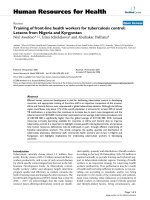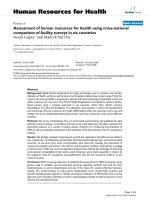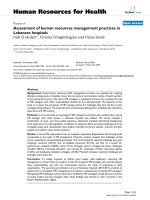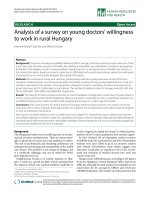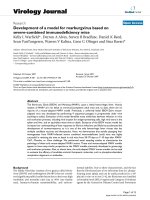Báo cáo sinh học: "Assessment of a Poisson animal model for embryo yield in a simulated multiple ovulation-embryo transfer scheme" potx
Bạn đang xem bản rút gọn của tài liệu. Xem và tải ngay bản đầy đủ của tài liệu tại đây (1.09 MB, 9 trang )
Original
article
Synaptonemal
complex
analysis
in
goats
carrying
the
5/15
Robertsonian
translocation
MEJ
Amaral
W
Jorge
2
1
Instituto
de
Biociencias,
Departamento
de
Genetica,
UNESP,
Campus
de
Botucatu,
18618-000,
Botucatu,
Sdo
Paulo;
2
Instituto
de
Ciencias
Biológicas,
Departamento
de
Biologia
Geral,
Universidad
Federal
de
Minas
Gerais,
31,
270-010
Belo
Horizonte,
Minas
Gerais,
Brasil
(Received
24
February
1993;
accepted
21
February
1994)
Summary -
Synaptonemal
complexes
were
analysed
by
electron
microscopy
in
2
bucks
heterozygous
for
the
5/15
Robertsonian
translocation.
The
cis
configuration
(free
homo-
logous
5
and
15
chromosomes
on
the
same
side
of
the
5/15
translocated
chromosome)
was
found
in
all
50
cells
examined.
This
feature
is
considered
a
prerequisite
for
the
development
of
balanced
gametes.
No
association
between
the
sex
bivalent
and
trivalent
was
observed.
meiosis
/ synaptonemal
complex
/
trivalent
/
Robertsonian
translocation
/
goat
Résumé -
L’analyse
du
complexe
synaptonémique
de
2
boucs
porteurs
de
la
translo-
cation
robertsonienne
5/15.
L’analyse
du
complexe
synaptonémique
a
été
effectuée,
en
microscopie
électronique,
chez
2
boucs
hétérozygotes
pour
la
translocation
robertsonienne
5/15.
La
configuration
cis
(chromosomes
homologues
5
et
15
situés
du
même
côté
du
chromosome-transloqué
5/15)
a
été
trouvée
dans
les
50
cellules
examinées.
Cette
carac-
téristique
est
considérée
comme
une
condition
préalable
au
développement
de
gamètes
équilibrés.
Aucune
association
entre
le
bivalent
sexuel
et
le
trivalent
n’a
été
détectée.
méiose
/
complexe
synaptonémique
/
trivalent
/
translocation
robertsonienne
/
chèvre
*
Correspondence
and
reprints:
1109
Southwest
Parkway,
Apt
1702,
College
Station,
TX
77840,
USA.
INTRODUCTION
Electron
microscopic
(em)
analysis
of
synaptonemal
complexes
(SC)
in
the
meiotic
cells
of
domestic
animals
carrying
chromosomal
aberrations
began
with
the
works
of
Switonski
et
al
(1987)
and
Gabriel-Robez
et
al
(1986).
Karyotype
analysis
of
2
Saanen
male
goats
with
2n
=
59
chromosomes
indicated
the
presence
of
a
submetacentric
chromosome.
The
G-banding
technique
was
used
to
identify
the
marker
chromosome
as
a
fusion
of
chromosomes
5
and
15.
Little
research
has
been
documented
concerning
SC
in
goats
possessing
either
normal
or
translocated
chromosomes.
To
investigate
the
effect
of
the
5/15
translocation
on
the
reproductive
capacity
of
the
heterozygous
animals,
SC
formation
and
the
behaviour
of
the
trivalent
5/15;
5 ;15
was
studied
at
the
pachytene
stage
of
meiosis.
MATERIALS
AND
METHODS
Two
Saanen
male
goats
(Capra
hircus),
both
59,
XY,
t(5 ;15)
heterozygous
for
the
translocation
were
studied.
Hemi-castration
was
immediately
followed
by
testicular
dissection
with
a
scalpel,
in
Hank’s
medium.
The
preparations
of
microspread
samples
were
made
according
to
the
technique
presented
by
Solari
(1980).
A
droplet
of
the
testicular
cell
suspension
was
added
to
approximately
5
ml
of
a
0.5%
NaCI
hypotonic
solution.
The
spread
nuclei
were
then
picked
up
by
touching
slides
pre-coated
with
plastic
film
on
the
surface
of
the
solution.
The
slides
were
immediately
immersed
in
a
Coplin
jar
containing
SDS
fixative
(4%
paraformaldehyde
and
0.03%
SDS,
pH
8,
adjusted
with
sodium
tetraborate
buffer)
and
incubated
for
5
min
at
room
temperature.
The
slides
were
then
held
on
the
surface
of
0.4%
Photoflo,
pH
8
for
30
s
and
allowed
to
air-dry.
Silver
nitrate
staining
was
performed
as
described
by
Howell
and
Black
(1980).
Nuclei
were
selected
by
light
microscopy
and
covered
with
50/75
mesh
grids.
The
plastic
film,
with
the
attached
nuclei
and
grids,
was
detached
from
the
slide
by
floating
on
water
and
collected
with
resined
paper.
Under
em,
the
magnification
was
1 600
x.
Micrographs
were
enlarged
5
x.
The
SC
lengths
(mm)
were
measured
individually.
Intact
nuclei
containing
a
complete
SC
set
were
used
to
construct
karyotypes.
The
normal
autosomal
bivalents
were
arranged
by
decreasing
size
and
aligned
by
the
kinetochore.
Each
trivalent
5/15,
5
and
15
was
put
in
the
position
of
bivalent
5
(see
fig
2
below).
The
XY
bivalent
occupied
the
last
position.
The
trivalent
5/15,
5
and
15
was
photographed
individually
and
enlarged
4200
x
for
detailed
analysis.
The
position
of
the
kinetochores
of
the
free
homologues
5
and
15
was
considered
cis
when
the
free
kinetochores
5
and
15
were
located
on
the
same
side of
the
5/15
chromosome,
and
trans
when
the
free
kinetochores
5
and
15
were
located
on
opposite
sides.
In
50
cells
containing
the
sex
bivalent,
the
presence
or
absence
of
association
of
the
trivalent
5/15,
5
and
15
and
the
sex
bivalent
was
noted.
RESULTS
Twenty-seven
autosomal
bivalents,
one
autosomal
trivalent
and
the
sex
bivalent
(figs
1
and
2)
were
observed
in
spermatocyte
preparations
from
the
heterozygous
5/15
translocated
buck
(2n
=
59).
In
all
the
analysed
nuclei
(50),
the
free
homologous
chromosomes
5
and
15
paired
in
the
cis
configuration
(figs
3
and
4).
In
the
trivalent,
the
pericentromeric
region
of
the
free
homologous
5
and
15
was
not
paired
at
early
pachytene
(fig
3).
At
mid-pachytene,
heterosynapsis
was
observed
between
the
pericentromeric
regions
of
the
free
homologues
5
and
15.
At
late
pachytene,
the
synaptic
adjustment
was
complete
and
the
centromeric
tips
of
the
free
homologues
5
and
15
were
completely
paired
with
the
translocated
corresponding
arms
(fig
4).
The
kinetochores,
however,
did
not
fuse
and
stayed
in
juxtaposition.
The
trivalent
5/15,
5
and
15
was
not
observed
to
be
associated
with
the
sex
bivalent.
DISCUSSION
In
this
paper,
the
trivalent
showed
the
pericentromeric
region
of the
free
homologues
5
and
15
not
paired
at
early
pachytene.
Late
synapsis
seems
to
be
a
characteristic
of
the
trivalents
as
is
described
in
bovine
(Switonski
et
al,
1987),
and
Lemur
hybrids
(Moses
et
al,
1979).
In
chinese
hamster
bivalents,
the
centromeric
region
is
also
the
last
to
form
SC
(Moses,
1977).
The
kinetochore
of
the
free
homologues
5
and
15
paired
preferentially
in
the
cis
configuration
with
their
homologue
portions
in
the
5/15
translocated
chromosome
and
were
visible
throughout
the
pachytene.
Moses
et
al
(1979)
observed
the
same
phenomenon
while
studying
trivalents
in
Lemur
hybrids
under
em.
Data
obtained
with
Capra
hircus
agree
with
the
results
of
Moses
et
al
(1979)
who
suggested
that
both
acrocentric
kinetochores
maintain
the
cis
configuration
independently
during
synapsis.
This
excludes
the
probability
of
variable
pairing
faces
and
leads
to
the
conclusion
that
a
single
pairing
face
on
the translocated
chromosome
determines
the
plane
of
SC
assembly.
The
cis
configuration
was
also
found
in
the
rodent,
Sigmodon
falviventer,
by
light
microscopy
(Elder
and
Pathak,
1980)
and
no
fertility
reduction
was
observed.
When
the
heterozygous
buck
was
crossed
with
normal
homozygous
or
hetero-
zygous,
females,
there
was
no
fertility
reduction
according
to
Goncalves
(personal
communication).
These
data
may
be
interpreted
as
an
indirect
sign
of
a
non-random
segregation
of
the
trivalent
chromosomes.
Moses
et
al
(1979)
noted
that
the
normal
fertility
rate
observed
in
Lemur
hybrids
in
related
to
a
mechanism
which
increases
the
frequency
of
balanced
gametes.
In
addition,
such
a
mechanism
would
specify
the
symmetric
arrangement
of
free
homologues
of
the
trivalent
at
pachytene.
The
hypothesis
which
suggests
that
the
symmetry
presented
by
the
translocated
chromosomal
arms
may
influence
the
configuration,
either
cis
or
trans,
should
be
considered.
It
may
be
well
accepted
that
the
more
asymmetric
the
translocation
arms,
as
in
bovine
translocation
1/29,
the
greater
the
probability
of
observing
the
trans
configuration.
Previous
studies
which
present
trivalents
in
the
cis
configu-
ration
only
support
this
assumption
since
cattle
with
t(4;8)
(Bouvet
et
al,
1989),
with
t(10;11)
(Elder
and
Pathak,
1980)
and
humans
with
t(13;14)
(Luciani
et
al,
1984)
present
very
symmetric
translocated
chromosomal
arms.
Perhaps
the
trans
configuration
becomes
less
probable
as
observed
if
the
chromosomal
arm
ratio
(long
arm/short
arm)
approaches
1.00.
There
are
morphological
differences
among
the
trivalents
that
result
from
centric
fusion
in
bovines,
humans,
rodents
and
caprines,
and
they
may
influence
the
association
with
the
sex
bivalent.
The
variation
in
the
position
of
the
acrocentric
chromosomes
neighbouring
the
sex
vesicle
produces
free
parts
with
a
stronger
tendency
to
pair
with
the
sex
chromosomes.
This
variable
tendency
could
explain
the
variation
which
occurs
in
the
phenotypic
expression
of
fertility
in
men
with
centric
fusion
(Johannisson
et
al,
1987).
Bouvet
et
al
(1989)
suggest
that
the
absence
of
association
between
the
sex
bivalent
and
the
autosomal
trivalent
could
explain
the
normal
spermatogenesis
presented
by
cattle
carrying
chromosomal
translocations,
while
mice
and
humans
carrying
similar
translocations
are
infertile
due
to
the
presence
of
such
associations.
In
the
present
case,
the
trivalent
was
not
observed
in
association
with
the
sex
bivalent.
In
studies
on
humans
(Johannisson
et
al,
1987)
and
mice
(Forejt
et
al,
1981)
it
was
assumed
that
the
reciprocal
and
Robertsonian
translocations
may
bring
about
either
sterility
or
infertility
if
the
unpaired
autosomes,
or
autosomal
segments,
pair
with
the
X
chrosomome.
The
authors
have
suggested
that
the
proximity
of
the
autosomal
segment
with
the
X
chromosome
may
interfere
with
its
inactivation
process
by
harming
the
germinative
cell.
This
kind
of
association
has
often
been
found
in
infertile
men
with
balanced
Robertsonian
translocation
between
chromosomes
13
and
14
(Luciani
et
al,
1984)
and
14
and
21
(Rosenmann
et
al,
1985).
In
all
of
the
micrographs
observed,
the
phase
of
unpairing
in
the
pericentromeric
region
of
the
acrocentric
5
and
15
was
restricted
to
the
beginning
of
pachytene
when
the
Y
chromosome
had
also
started
pairing
with
the
X
chromosome.
ACKNOWLEDGMENTS
We
would
like
to
thank
A
Solari,
University
of
Buenos
Aires,
for
help
in
the
technique
adaptation,
Y
Yonenaga-Yassuda,
Bioscience
Institute,
USP,
Sao
Paulo,
for
assistance
in
the
analysis
of
the
results,
EA
Greg6rio
and
MH
Moreno,
Electron
Microscopy
Center,
IB,
UNESP,
Botucatu,
for
utilization
of
the
electron
microscope
and
CAPES
for
support
of
the
project.
REFERENCES
Bouvet
A,
Popescu
CP,
Giovanni-Macchi
AM,
Colombo
G,
Molteni
L
(1989)
Synaptonemal
complex
analysis
in
a
bull
carrying
a
4 ;8
Robertsonian
translocation.
Ann
Genet
32,
193-199
Elder
FFB,
Pathak
S
(1980)
Light
microscopic
observations
on
the
behavior
of
silver-stained
trivalents
in
pachytene
cells
of
Sigmodon
fulviventer
(Rodentia,
Muridae)
heterozygous
of
centric
fusion.
Cytogenet
Cell
Genet
27,
31-38
Forejt
J,
Gregorov
S,
Goetz
P
(1981)
XY
pair
associates
with
the
synaptonemal
complex
of
autosomal
male-sterile
translocations
in
pachytene
spermatocytes
of
the
mouse
(Mus
musculus).
Chrorrcosoma
82,
41-53
Gabriel-Robez
0,
Ratomponirina
C,
Dutrillaux
B,
Carr6-Pigeon
F,
Rumpler
Y
(1986)
Meiotic
association
between
the
XY
chromosomes
and
the
autosomal
quadri-
valent
of
reciprocal
translocation
in
two
infertile
men
46,
XY,
T(19;22)
and
46,
XY,
t(17;21).
Cytogenet
Cell
Genet 43, 154-160
Howell
WM,
Black
DA
(1980)
Controlled
silver-staining
of
nucleolus
organizer
regions
with
a
protective
colloidal
developer:
a
1-step
method.
Experientia
36,
1014-
1015
Johannisson
R,
Lohrs
U,
Wolff
HH,
Schwinger
E
(1987)
Two
different
XY-
quadrivalent
associations
and
impairment
of
fertility
in
men.
Cytogenet
Cell
Genet
45,
222-230
Luciani
JM,
Guichaoua
MR,
Mattei
A,
Morazzani
MR
(1984)
Pachytene
analysis
of
a
man
with
a
13q;14q
translocation
and
infertility:
behaviour
of
the
trivalent
and
nonrandom
association
with
the
sex
vesicle.
Cytogenet
Cell
Genet
38,
14-22
Moses
MJ
(1977)
Synaptonemal
complex
karyotyping
in
spermatocytes
of
the
Chinese
hamster
(Cricetulus
grise!s).
I.
Morphology
of
the
autosomal
complement
in
spread
preparations.
Chromosoma
60,
99-125
Moses
MJ,
Karatsis
PA,
Hamilton
AE
(1979)
Synaptonemal
complex
analysis
of
heteromorphic
trivalents
in
Lemur
hybrids.
Chromosoma
70,
137-141
Rosenmann
A,
Wahrman
J,
Richler
C,
Voss
R,
Persitz
A,
Goldman
B
(1985)
Meiotic
association
between
the
XY
chromosomes
and
unpaired
autosomal
elements
as
a
cause
of
human
male
sterility.
Cytogenet
Cell
Genet
39,
19-29
Solari
AJ
(1980)
Synaptonemal
complex
and
associated
structures
in
microspread
human
spermatocytes.
Chromosoma
81,
315-337
Switonski
M,
Gustavsson
I,
Ploen
L
(1987)
The
nature
of
the
1;29
translocation
in
cattle
as
revealed
by
synaptonemal
complex
analysis
using
electron
microscopy.
Cytogenet
Cell
Genet 44,
103-111


